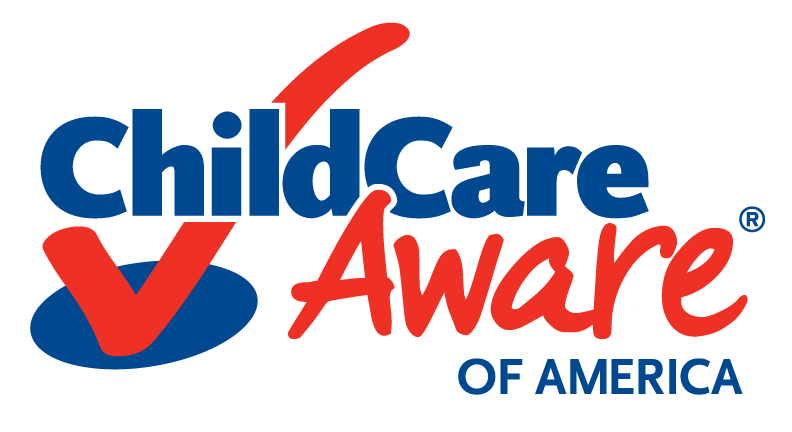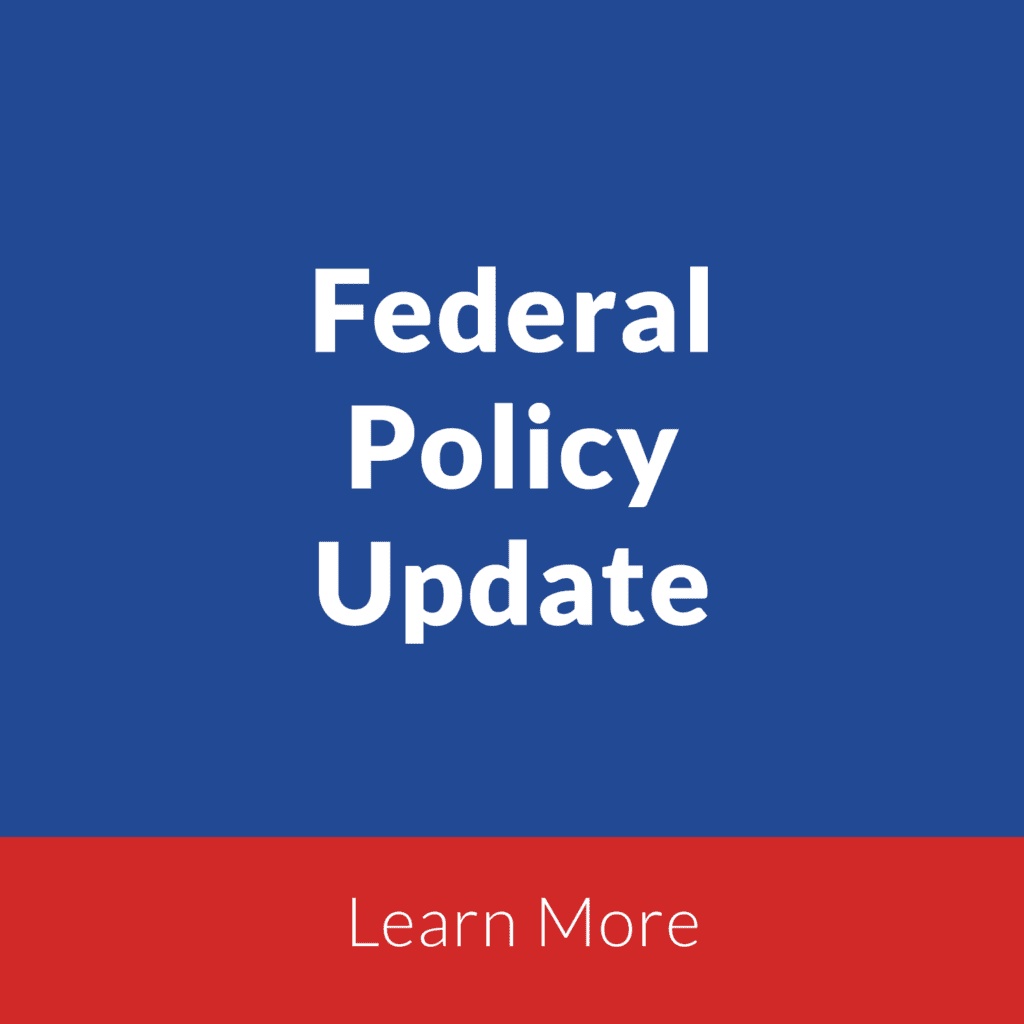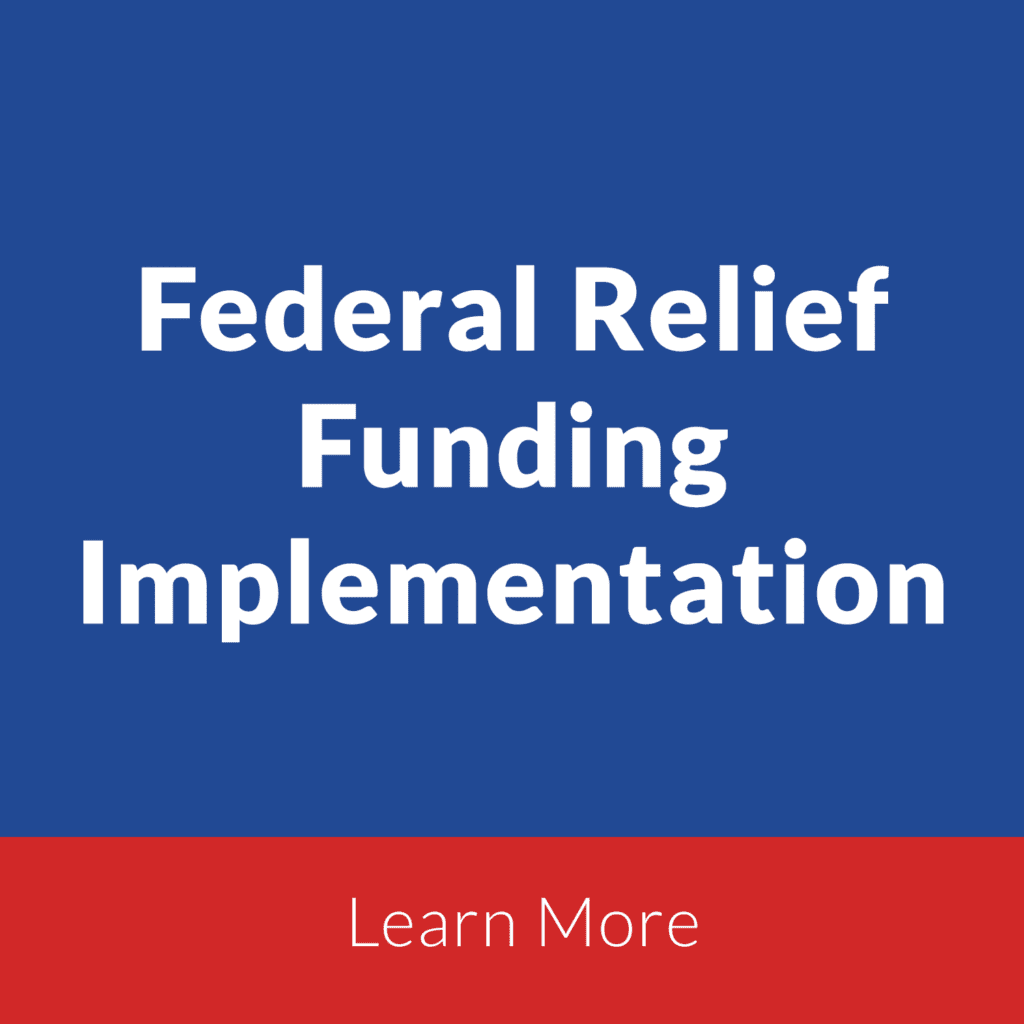Catalyzing Growth: Using Data to Change Child Care
Our child care system is in crisis. The COVID-19 pandemic made a weak, disjointed system crumble even further. Parents struggle to find accessible, affordable, quality child care while the child care workforce is shrinking due to decades of low pay and a lack of respect regarding the critical nature of its work.
How can we catalyze or accelerate the changes that our child care system needs to overcome these challenges? One important factor is data. In this series of reports, Child Care Aware® of America will use data from various sources to answer this question. In our first report, Annual Child Care Landscape Analysis: 2021 Supply and Quality Trends, data from our most recent survey of Child Care Resource and Referral (CCR&R) agencies is used to explore how the supply of child care has changed since 2019. In our second report, Price of Care: 2021 Child Care Affordability, we update our child care affordability data and national price averages. Our final report, The Year in Child Care: 2021 Data, Analysis and Recommendations, summarizes all of the research work that CCAoA has done over the past year, while highlighting key child care data findings from studies conducted outside of CCAoA. With the right data, we can catalyze the growth that our child care system needs in order to work for all families and providers.
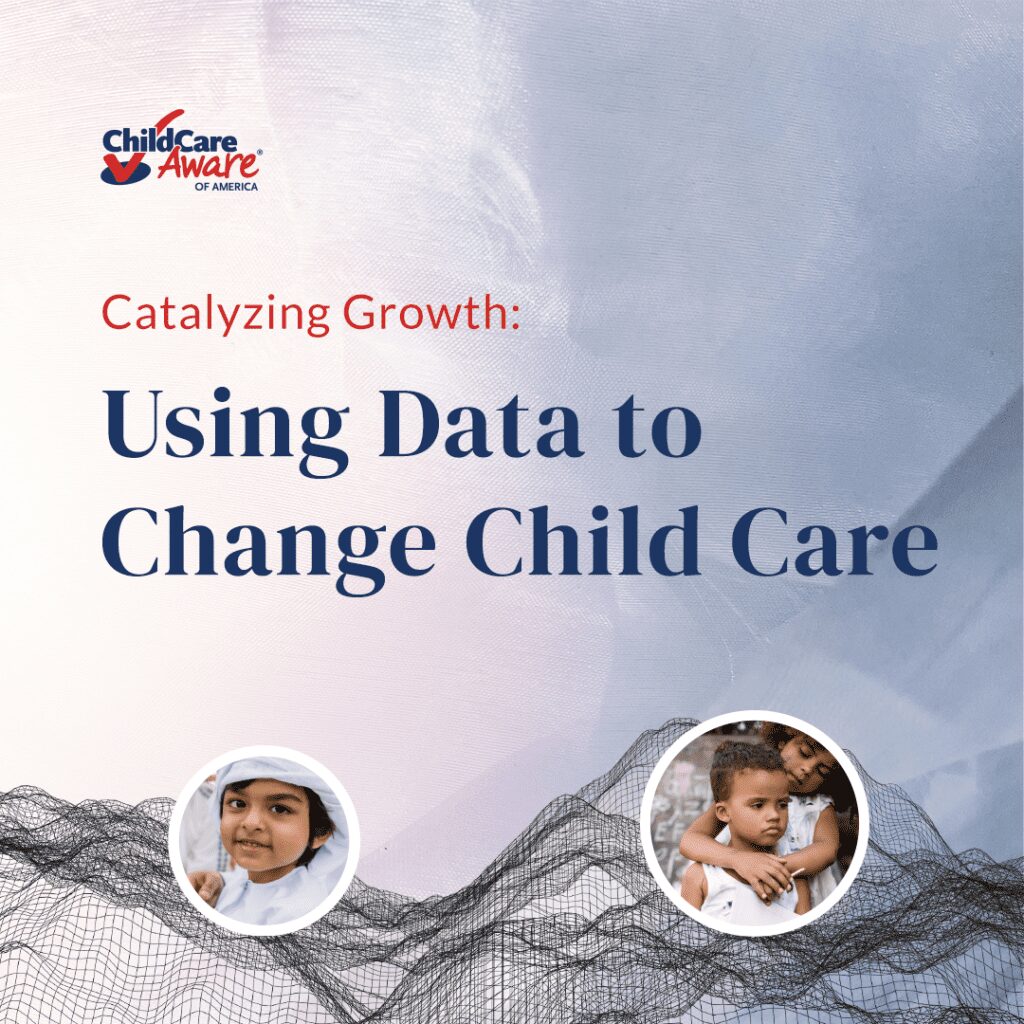
View the most up-to-date data, click here.
Download
The Year in Child Care: 2021 Data, Analysis and Recommendations (PDF)
Annual Child Care Landscape Analysis:
2021 Supply and Quality Trends
Our child care system continues to experience multiple crises, with families finding it difficult to locate reliable child care that they can afford. Between 2020 and 2021, the overall supply of child care programs continued to decrease, leaving families with even fewer options than before the pandemic. This was driven primarily by a continuing (or long term trend) decline in Family Child Care Homes over the period. While stabilization funds may have helped limit the decrease in programs, without significant new, permanent investments in early care and education in this country, the challenges associated with the child care system will continue. Understanding this landscape is a crucial first step towards advocating for an equitable, accessible and affordable child care system.
Tracking child care supply is critical to understanding how our child care system is functioning. In order to provide this critical data, Child Care Aware® of America releases its Annual Child Care Landscape Analysis. The goal of the Annual Child Care Landscape Analysis is to help child care advocates and policymakers easily understand the child care supply in their states. This year, the Landscape Analysis includes the following information, by state:
- Number of licensed child care centers and family child care (FCC) homes open at the end of 2019, 2020 and 2021;
- Number of licensed school-age child care programs open at the end of 2021;
- Total licensed capacity for centers, FCCs, and school-age child care programs at the end of 2021;
- Number of programs participating in quality rating and improvement systems (QRIS), along with the total capacity of these programs;
- Total number and licensed capacity of programs rated at the highest level of the state’s QRIS;
- Total number of child care referrals provided to families by child care resource and referral (CCR&R) agencies.
This year, CCAoA is featuring longitudinal supply data to increase user understanding regarding how the supply of child care has changed since 2019, prior to the start of the COVID-19 pandemic. Nationally, we found that while there was an increase in the number of child care centers from 2020 to 2021, the total number of centers remains slightly lower than the number open in 2019.
There continues to be a downward trend in the supply of licensed FCC homes. Among the 40 states for which we have complete data, we found a decrease from 107,783 in 2019 to 97,393 in 2021. Even before the COVID-19 pandemic, the supply of FCC homes was decreasing. This is an alarming trend because FCC homes are an affordable option for many families. FCC homes are often the only choice for families, especially in rural communities.
Methodology
The information found in the state fact sheets comes from a variety of sources. In January 2022, CCAoA surveyed state Child Care Resource and Referral (CCR&R) agencies or other key child care stakeholders in each state (for example, state agencies responsible for administering the federally-funded Child Care and Development Block Grant). The survey covered the following topics: child care supply and capacity, quality rating and improvement systems (QRIS), CCR&R services and annual child care prices. Respondents were asked to complete the survey based on data as of December 2021. Data from the survey not included here, such as those on price, will be presented in upcoming CCAoA reports.
Some states have more data points present in their Child Care Landscape Analysis than others. Some states are unable to answer some survey questions because of differing definitions or not collecting certain data points. Child care supply and QRIS data were gathered from public databases for the following states: Alabama, California, District of Columbia, Mississippi, New Jersey, New Mexico, Texas and Wyoming.
If you need more information about the Child Care Landscape Analysis methodology, please contact us at research@usa.childcareaware.org.
Price of Care:
2021 Child Care Affordability
Child care prices remain high. At a time when prices for a number of goods have increased, child care prices continued to outpace inflation in 2021, according to CCAoA’s Child Care Affordability Analysis.
This is bad news for families, who struggle to afford child care. This is also bad news for employers and communities, who benefit from widespread access to affordable, high-quality child care. Unfortunately, past public investments have not been enough to fully support the system and have created a precarious situation for child care, one that relies heavily on families to foot the bill. While recent investments in response to the COVID-19 pandemic may have helped to stabilize some of the supply of child care, the system and the families it serves are still fighting toward thriving.
Women have been particularly hard hit by the lack of affordable child care. Recent findings from the RAPID-EC survey indicate that 40% of female respondents had left their jobs or cut back on their work schedules – most of them due to child care constraints. When families don’t have access to affordable, high-quality child care, children miss out on important child development opportunities, employers face losses as they struggle to find workers, and our economy sees overall challenges.
CCAoA’s Child Care Affordability Analysis found that in 2021:
- The national average price of child care was around $10,600 annually. This would comprise 10% of a married-couple family’s average annual income and 35% of a single parent’s income.
- The increase in child care prices slightly outpaced inflation, which was much higher than the inflation rate in prior years.
- In most states, the price of child care for two children exceeded annual housing payments by 28% to over 100%.
- Similarly, the price of child care for an infant in a center exceeded annual in-state tuition at a public university in 34 states.
- Child care for two children in a center would cost a child care workforce professional anywhere from 56% to over 100% of annual income.
- Child care was more expensive than most other household expenses such as housing and health care in all U.S. regions.
Tracking the Annual Price of Care
CCAoA updates estimates of the price of child care for different child age groups and provider types annually. Data in this analysis comes from a survey of Child Care Resource and Referral agencies (CCR&Rs) in all 50 states and the District of Columbia that CCAoA sent out in February 2022. This survey contained a series of questions asking agencies to report the annual price of child care in 2021 for infants, toddlers and 4-year-olds in regulated center-based and family child care homes. There were also questions about the price of care for school-age children before and after school and during the summer for regulated, private centers and family child care homes. For states that did not respond to the survey, CCAoA used data from the state’s most recent market rate survey, adjusted for 2021 inflation. For state-by-state affordability tables, please see the Child Care Affordability Analysis.
Child Care Prices Continue To Outpace Inflation
CCAoA’s analysis found that increases in the price of child care have exceeded the average annual rate of inflation for the past three years. The table below shows that in 2019 and 2020, child care prices exceeded the inflation rate by less than 1 percentage point and nearly 4 percentage points, respectively. In 2021, the average annual inflation rate was higher than usual at 4.7%. Child care prices rose by an average of 5% when compared to 2020 prices. This means that child care prices exceeded historically high inflation by 0.3 percentage points and, thus, families with children are more likely to struggle to afford child care on top of essentials such as food, housing and transportation.
Child Care Continues to Top the Charts of Common Household Expenses
As part of this analysis, CCAoA compared the annual price of child care to average housing payments. In all states plus the District of Columbia, child care prices for two children exceeded annual rental payments by 28% to over 100%. Meanwhile, the price of child care for two children in a center exceeded annual mortgage payments in 44 states plus the District of Columbia.
In 34 states plus the District of Columbia, the annual price of child care for an infant in a center exceeded annual in-state tuition at a public university.
Child care is particularly unaffordable for those in the child care workforce. As in prior years, CCAoA found that child care for two children in a center exceeds the average annual income for child care professionals. The price of care for two children in a center exceeded annual income for this sector of the workforce from 56% to over 100%.
Figure 1 provides a comparison of child care prices to other common household expenses by region. In three out of four regions, the annual price of center-based child care for an infant exceeds the cost of housing. In all four regions, the annual price of child care exceeds the annual cost of in-state tuition at a public four-year university.
Figure 1. Average Annual Household Expenses by Region**.
National Child Care Price Estimates are Above the Recommended 7% of Household Income
The average of each methodology described below (both provider types and age groups), produces a national annual average price of child care of approximately $10,400 to $10,800. While readers should take caution when interpreting these numbers because the nation’s child care landscape varies dramatically from state to state, comparing these figures to the national median income for married couples with children under 18 highlights that it would take more than 10% of household income to cover the child care prices for one child. This is more than the U.S. Department of Health and Human Services recommendation that child care should cost no more than 7% of a household’s income. The situation is more dire for single parents, as the average national price of child care comprises 35% of the median household income for single-parent families.
Click on your state to see the full price of child care breakdown:
Each year, CCAoA generates state-based rankings by affordability — the percent of median household income needed to cover the average price of child care in that state – and CCAoA began estimating a national price of child care in 2018. To increase accuracy and interpretation, CCAoA conducts and reports three approaches for calculating the average child care prices for infants and 4-year-olds in center-based care as well as for family child care homes. See each methodology below for more details. School-age prices were not included at this time because of the variability in data on these prices across the country.
It is important to understand the following considerations when interpreting a national average price for child care. Each year, extraordinary efforts are involved in making sure that each state is represented accurately; CCAoA’s research team works very closely with CCR&R staff to ensure that data is collected as uniformly as possible. However, each state’s child care landscape is nuanced and unique, and differences may be hidden when attempting to calculate a national average. CCAoA generally does not recommend using a national average of child care prices, and particularly not as a standard of comparison with any state’s average prices of child care.
Within this context, CCAoA is reporting national average price estimates. CCAoA developed three methodologies that take into account such factors as number of slots by age group and number of programs, which could affect the price of child care in states. Explanations of each methodology, along with calculations, are below. None of these methods is ideal for determining one number that accurately describes child care affordability across the country. Though these three methods produce similar numbers, none of methodologies unpacks the complexities of child care affordability. Prices of a service like child care are better understood in the context of household income, by state and by regions within states.
The Year in Child Care
2021 Data, Analysis and Recommendations
Download
The Year in Child Care: 2021 Data, Analysis and Recommendations (PDF)
The Year in Child Care: 2021 Data, Analysis and Recommendations is the final report of Child Care Aware® of America (CCAoA)’s Catalyzing Growth: Using Data to Change Child Care series. Together with the earlier reports, 2021 Child Care Landscape Analysis and 2021 Child Care Affordability Analysis, this report presents a comprehensive look at the child care system’s recent challenges and opportunities. In The Year in Child Care: 2021 Data, Analysis and Recommendations, we aim to:
- Understand how different groups of stakeholders (families, the child care workforce and Child Care Resource and Referral agencies (CCR&Rs)) have coped with child care challenges throughout the COVID-19 pandemic.
- Give readers a fuller picture of child care affordability by comparing child care prices to median household income by marital status and race/ ethnicity.
- Show how child care supply does not match with potential demand through an analysis of licensed capacity.
Throughout these three sections, we will also highlight child care-related findings from other researchers over the past year. These findings will help readers better understand the current state of child care and be better equipped to push for changes to our child care system. Child care is an issue that affects the entire U.S. economy. When families have access to affordable, high-quality child care, we grow a stronger econom
Families, Child Care Workforce and CCR&Rs: Struggles and Innovations
Analysis: What Challenges Have Families and the Child Care Workforce Faced Since 2020?
Since the beginning of the COVID-19 pandemic, there have been multiple efforts to survey families with children and child care providers to find out how they have coped during this time. One of the most comprehensive sets of surveys is RAPID, which was first administered by the University of Oregon and now by Stanford University. Since April 2020, the RAPID survey has asked families with children under age 6 about their daily experiences. Families are surveyed twice per month on topics such as financial stressors, emotional well-being, child behavior and child care challenges. In May 2021, a new RAPID Survey tool was launched to ask child care providers about their experiences amid the ongoing COVID-19 pandemic. A sample of child care providers is surveyed twice per month on their current financial and emotional well-being, along with other questions about the challenges they are facing. The RAPID survey team at Stanford University generously provided data as of September 30, 2022, for both the family and child care provider surveys. Below, we present some key findings from our analyses. Please download the report PDF for all of the analyses and findings.
Over half of parents are using child care arrangements, but many are struggling to find spaces for their children and have difficulty paying for child care.
The RAPID Survey also asked parents about their current child care arrangements. In the September 2022 administration of RAPID, over half of respondents reported that they have used child care in the month prior to completing the survey (55%). The average number of hours their children spent each week in child care varied by setting. Parents who used center-based care used it an average of 35 hours per week, while those who used family child care homes reported an average use of 40 hours per week. Those who used family, friend and neighbor care (both paid and unpaid) reported that they use it for an average of 16 hours per week.
Child care has been a source of stress for parents who took the RAPID Survey. In the September 2022 administration of RAPID, more than 75% of parents reported that they have had difficulty finding a child care space, and 70% stated that this difficulty has impacted their ability to work. Meanwhile, nearly 30% of parents experienced moderate to extreme levels of stress due to difficulty paying for child care. These results should be interpreted with caution, however, due to a low sample size during this survey administration window (N = 30).
Overall, parents who participated in the RAPID Survey are looking for the same qualities in a child care arrangement now that they were seeking before the pandemic. The pandemic seems to have reduced the supply of child care even more than pre-pandemic losses, most likely leading to increased difficulty for parents finding child care, which could be impacting their ability to work. According to data from the RAPID Survey of child care providers, rising prices are impacting them as well.
Over half of child care providers report feeling stressed about paying for food and utilities.
The RAPID Survey asked child care providers a series of questions about financial stress. Figure 4 shows that food and utilities were the two expenses that child care providers struggled the most to pay for in the month prior to completing the survey. Similarly, over 50% of child care providers felt moderate or extreme stress when paying for utilities and food in the month prior to completing the survey.
Many providers surveyed have concerns about the ongoing child care staffing crisis.
The RAPID Survey asked a series of questions about the ongoing child care staffing crisis and how it was affecting providers’ well-being. According to data collected in May 2022, 34% reported that their programs experienced staffing shortages prior to COVID-19, and 61% reported that their programs were currently experiencing shortages. As seen in Table 2, these shortages have led to many child care providers feeling more stressed, anxious and exhausted.
Analysis: How are CCR&Rs Supporting the Child Care Workforce?
In August 2021, CCAoA sent a survey to CCR&R leaders across the country. The goal of this survey was to discover how CCR&Rs are helping support the child care sector in their communities. In the report pdf, we analyzed data to answer the following research questions:
- What services do CCR&Rs provide to child care providers and their staff?
- What strategies are CCR&Rs using to recruit new and retain existing child care providers?
- How are CCR&Rs supporting FCC providers?
Technical assistance and training were the most provided services to both centers and family child care (FCC) providers. More than 50% of CCR&Rs also provided the following services to child care providers in both centers and FCCs: mentoring/coaching, accessing grant funding, business support (e.g., helping providers become better business managers) and licensing support (e.g., helping providers navigate state and local child care regulations).
To help recruit new and retain existing child care providers, CCR&Rs often:
- Use marketing tools such as phone calls, newsletters and emails
- Attend community events such as job fairs, local festivals and block parties
- Conduct pre-service and business training or technical assistance activities
- Develop partnerships with schools, community organizations and government agencies
- Assist child care programs with completing financial assistance and grant applications
- Provide gifts and incentives to existing child care providers
Our survey found that CCR&Rs assist FCC providers by providing supplies, conducting virtual trainings and having dedicated FCC support staff members.
Check out our PDF for a full analysis of our findings.
Child Care Affordability
Analysis: Comparing Child Care Prices to Different Household Demographics
Child care was less affordable for households of color who are headed by divorced or single parents.
In October 2022, CCAoA released its Child Care Affordability Analysis. This report provided updated child care price data as of 2021, along with comparisons of child care prices to median household income for married couples with children and single, female-led families. However, with this report we aim to better understand how child care prices compare to the median household income of U.S. families with diverse demographics. To that end, we incorporated marital status and race/ethnicity data from the 2021 Annual Social and Economic Supplement (ASEC) conducted by the U.S. Census Bureau into our analyses. We filtered this dataset to include households using the following variables:
- Households with at least one child under age 6
- Head of household is in the labor force
In our analysis, we created cross-tabulations with the following variables:
- Race of household members
- Hispanic/Latino ethnicity of household members
- Marital status: married, divorced and single/never married
- Median income in 2021
We compared the 2021 annual national average price of child care from the Child Care Affordability Analysis ($10,681) to the median income of households with young children by three marital status types and the race/ethnicity of household members. The table below shows that child care prices can cost married couple households anywhere from 7% to 14% of their household income, depending on their racial group. Among households led by divorced parents, child care could cost between 20% for households that identify as multiracial to 31% for American Indian/Alaska Native households. Finally, for households led by a single parent who has never been married, child care can cost a range of 31% of median income for white and Asian households to 49% of median income for American Indian/Alaska Native households.
Child Care Supply
Analysis: Licensed Child Care Slots Versus Potential Demand
Nationally, there was a child care supply gap of 3.6 million slots in 2021.
For this report, we compared the number of licensed slots that were reported in our 2021 annual survey to potential child care demand for young children. To complete this analysis, we included the following variables.
- Licensed child care slots: The total licensed capacity for center-based programs and FCC providers reported by states on the 2021 CCAoA annual survey. This measure refers to the maximum number of children for which a program is licensed to care. For this analysis, we only included potential demand for the 43 states that reported licensed child care slot numbers in our 2021 annual survey.
- Potential child care demand: This data point was gathered from the 2021 one-year estimates from the American Community Survey, a product of the U.S. Census Bureau. Table B23008 lists the total number of children under age 6 in each state with all parents in the workforce. We use this number as a proxy for potential child care demand.
Based on the analysis of 43 states who reported licensed capacity data, there were a total of 8.7 million slots in licensed child care centers and FCC providers in 2021. The number of children who potentially needed child care in these states totaled 12.3 million in 2021. This leaves a licensed child care supply gap of 3.6 million slots, which is similar to but slightly higher than what was found in the Bipartisan Policy Center report referenced above.
All four U.S. regions have fewer licensed child care slots than potential demand. The South and West each had a supply gap of over 1 million licensed child care slots in 2021.
We also conducted an analysis of these numbers at the regional level. Table 10 shows that the South and West regions had the largest supply gaps of over 1 million licensed child care slots each. However, the Northeast and Midwest each have a supply gap of over half a million.
Conclusion
CCAoA’s data and analysis complement the reports of many other organizations and create new knowledge about the supply and affordability challenges families face in accessing high-quality child care. Families face child care disruptions in addition to stresses associated with rising prices and economic uncertainty. Child care workforce turnover continues to challenge the ability of child care providers to adequately staff their programs. Child care continues to be unaffordable for many families while wages and other compensation for the early care and education workforce remain too low. This research supports a call for bold policy action aimed at increasing the supply of child care to support children, families and the workforce. Policymakers, system leaders, and other stakeholders should commit to increased investment in the child care and early learning system, and take steps to address gaps in supply, high prices for families, and inadequate compensation for workers. Learn more about CCAoA’s policy and advocacy work and how you can be an advocate for child care change here.
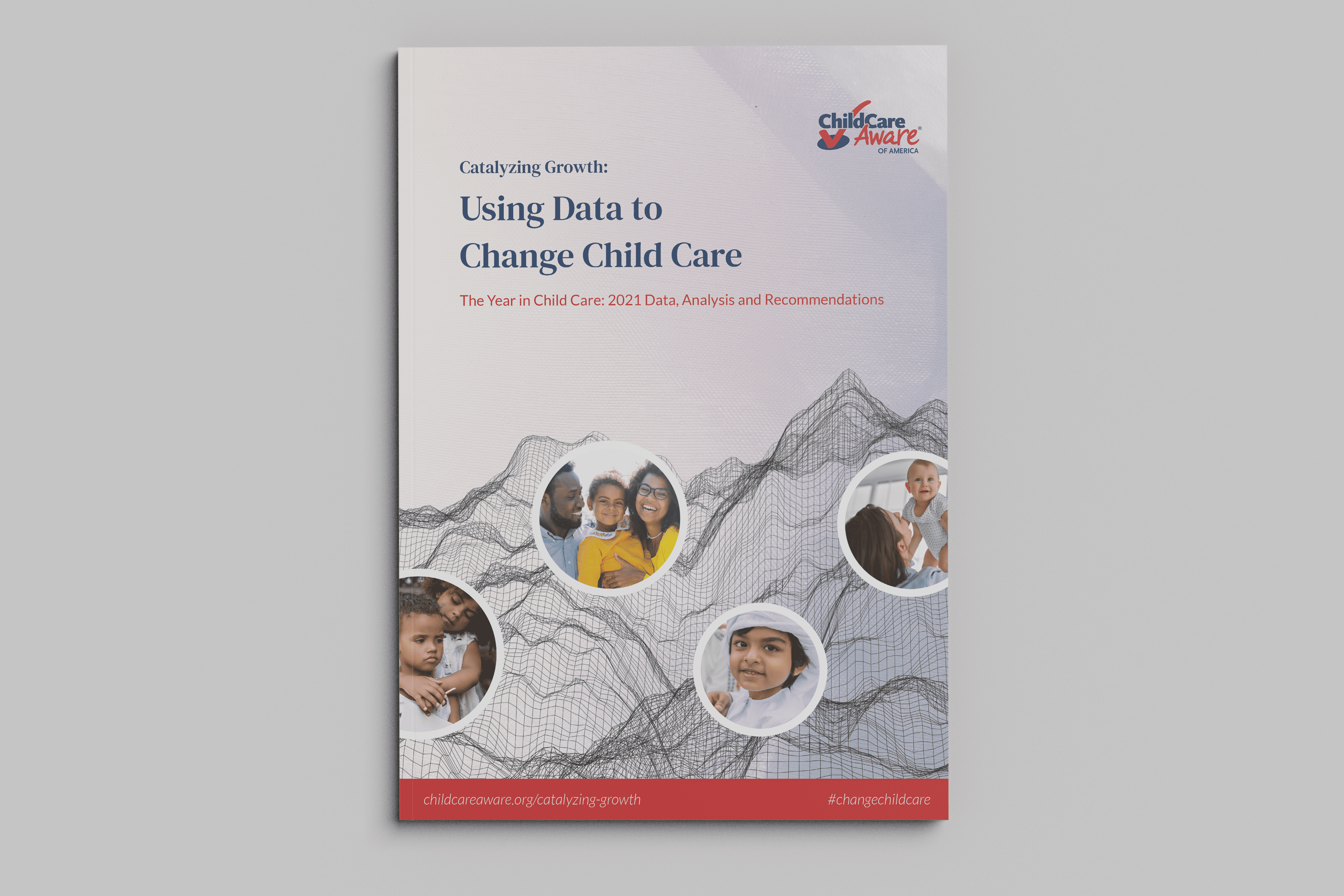
The Year in Child Care: 2021 Data, Analysis and Recommendations
Dig Deeper
Use our Child Care Data Center to explore state- and county-level data about child care affordability, accessibility, health and the impact of COVID-19 on child care supply from six pilot states (Illinois, Minnesota, Missouri, Oregon, Washington and Wisconsin).
Want to Do More?
Get involved in the effort to ensure that every family in the U.S. has access to a high-quality, affordable child care system. You can help make that vision a reality by sharing this critical information with your policymakers and encouraging them to invest in child care and early learning. You can also share this information with your network by utilizing our social media toolkit. For more information on what is happening at the federal, state, and local levels around child care policies, view our additional resources.
Additional Resources:
